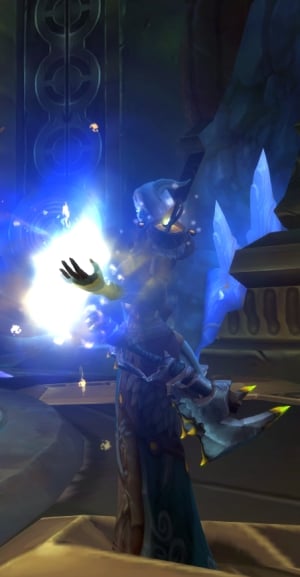
The one down side to working ahead is that sometimes your schedule gets nudged around more than expected. I promise that a further look at the changed and underused zones in World of Warcraft is on its way (and written, even), but it keeps getting delayed, first because of book reviews and then hold on, what the heck is this?
This is the equivalent of doing an experiment in a lab to discover that gravity accelerates a falling body at a rate of 4.9 meters per second squared. Something is very, very wrong here.
Of course, if you actually got that result, you wouldn’t immediately publish a paper detailing that gravity no longer worked the way we all knew it did. So let’s examine two possible reactions to the rather surprising lack of WoW on the Superdata chart, because there’s more to seeing a surprising result than just nodding and accepting that it must be the new normal.
Something has gone awry
 Let’s extend that above analogy. If you had data showing 4.9 as the gravitational constant, you wouldn’t just nod and publish those results; you’d ask what the heck happened. You’d check your instruments and your other findings, run the experiment again, and quite possibly look for another explanation for the same data. Because that result doesn’t make any sense.
Let’s extend that above analogy. If you had data showing 4.9 as the gravitational constant, you wouldn’t just nod and publish those results; you’d ask what the heck happened. You’d check your instruments and your other findings, run the experiment again, and quite possibly look for another explanation for the same data. Because that result doesn’t make any sense.
So rather than assuming that WoW suddenly not showing up on Superdata is a sign of doom, perhaps it’s better to ask if something went awry during the collection of data.
We know that Overwatch dropped off last month, but the loss of the almost always-present WoW raises some questions about how the data were obtained and whether or not they’re entirely accurate. It’s possible that data were not collected or shared accurately, or someone misplaced a zero somewhere along the line. Obviously a great deal of work goes into these reports, but mistakes can still get made. Let’s not forget when Superdata kept splitting the game up and thus misreporting it.
It also seems odd considering that November was also the site of BlizzCon, and while a lot of digital ink has been spilled about how badly that went, the response to the various WoW reveals was less “savagely negative” and more “tepid.” There was only one real hiccup that didn’t go over well (8.2’s Mechagon dungeon), most of it produced some amount of assent from the crowd. Usually a big convention boosts numbers, after all.
Plus, let’s note that The Sims 4 is now occupying WoW’s spot of 7 from last month. That is, again, an odd result. This isn’t a game that’s been a longtime favorite or one that has frequently jockeyed for a spot there; it winds up being an unusual inclusion while a usual suspect is not present there.
Also, while you may be tired of hearing about it, let’s not forget that China’s game market has been in freefall for ages now, and it’s only just now starting to change at all. That’s going to have a knock-on effect, especially for titles like WoW that have a major impact in the region.
In other words, it’s important to look at these numbers and take them with a grain of salt before assuming the worst. This is not in and of itself evidence to support a thesis statement of how badly the game’s latest expansion has ruined everything; it’s a data point that may be irrelevant next month. It’s the equivalent of an odd computer error: Rebooting might fix the problem, which means it’s not really a problem.
But if it’s accurate?
 Having said all of that, I’d be less inclined to believe that this was wrong if it weren’t for the fact that Overwatch slipped off last month. That game has been Blizzard’s golden child pretty much since launch, and as a result the game has benefited the most from attention and visibility. And it’s used that to more or less just produce more of that it already has and ignore people asking for, well, more than just a lobby-based shooter with storytelling that’s going nowhere.
Having said all of that, I’d be less inclined to believe that this was wrong if it weren’t for the fact that Overwatch slipped off last month. That game has been Blizzard’s golden child pretty much since launch, and as a result the game has benefited the most from attention and visibility. And it’s used that to more or less just produce more of that it already has and ignore people asking for, well, more than just a lobby-based shooter with storytelling that’s going nowhere.
And, yes, it seems like people have gotten kind of tired of it. Remember talking about market saturation? Yeah.
Of course, we’re not here to talk about Overwatch; we’re here for WoW, which has been on these charts for much longer and now does not appear to be. And if that’s all entirely accurate, that points to a problem that ties right back into when Blizzard decided to stop publishing subscriber numbers a while back.
See, Blizzard’s decision to stop offering numbers in 2015 was born out of cold business sense. The falling numbers (and they were falling) made the game look as if it was doing worse, which it was in terms of subscribers, but in terms of revenue it was doing just fine. Sure, it was doing fine by finding ways to get more money out of fewer players, but from a business standpoint that doesn’t actually matter too much. Whether you make $1,000 by charging 500 people $2 each or by charging 100 people $10 each, you still made $1,000. So no more numbers, revenue looks fine, and everything’s great!
Well… until things start falling further. Consider the numbers I just posited: If you lose 10 players from the first scenario, you still have 490 playing and wind up making $980. It’s a loss, but a small one. But if you lose 10 players from the second scenario, you’re only making $900.
In other words, it doesn’t actually matter how you’re hitting those numbers for a given month, but it does matter in the long run. One way is a lot less elastic and thus can be much more dangerous. Say, if you release an expansion that gets a terrible reception, weak word-of-mouth, and a development team doubling down on the design choices that cause all of these problems rather than trying to make major changes to avert this problem.

Has doom come to our world (of warcraft)?
Let’s be realistic here. Whether or not the loss of a slot on Superdata is accurate, it’s almost certainly not the end of the world. Companies tend to look at things on a more quarterly than monthly basis, and the game has more than enough money to be just fine even if it’s going through a rough patch. Heck, it’s entirely possible that this is more indicative of how data have been collected than of an actual problem.
But it should serve as a splash of cold water regardless. These November numbers are coming when we’re only three months out from an expansion launch, which is a pretty alarming drop-off. If I were Ion Hazzikostas, I’d probably be sitting in my office and looking back through design documents right now because some of my decisions are obviously not working out right.
This isn’t an ode of doom for the next year, nor does it mean that the game is going to massively scale back or that Blizzard is going to shutter the title. But between this and what’s happened with Heroes of the Storm, it all does add up to a studio that might be well-served to check its feelings of invulnerability against the cold reality of the markets.
Or, in short, don’t be surprised if next year brings some pretty big changes.
Feedback, as always, is welcome in the comments below or via mail to eliot@massivelyop.com. Next week, yes, it should be back to zones. Or another news explosion, who knows.
 War never changes, but World of Warcraft does, with a decade of history and a huge footprint in the MMORPG industry. Join Eliot Lefebvre each week for a new installment of WoW Factor as he examines the enormous MMO, how it interacts with the larger world of online gaming, and what’s new in the worlds of Azeroth and Draenor.
War never changes, but World of Warcraft does, with a decade of history and a huge footprint in the MMORPG industry. Join Eliot Lefebvre each week for a new installment of WoW Factor as he examines the enormous MMO, how it interacts with the larger world of online gaming, and what’s new in the worlds of Azeroth and Draenor.













